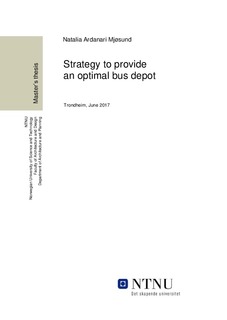| dc.description.abstract | The purpose of this master thesis is to seek a greater understanding about the importance of a bus depot in urban development. It highlights the characteristics of an optimal bus depot where Oslo, Akershus, Hordaland, Stockholm and Trondheim are selected as the study case. The research study will describe the strategies of these regions to provide bus depot to their transport system. SWOT analysis and urban brief are used as analyzing tools to the research study.
Environmental protection is one of the imperative tasks for the government. Through environmental awareness campaign, the government promotes the importance of emission decline by encouraging community to use actively public transport, cycling, or walking, rather than private cars. One of the success factors to make public transport works is that the infrastructure and facility for the operation is provided.
Bus depot has important roles for a region that chooses bus mode in their transport system. Bus depot development attracts many attentions in the world of real estate development as it is a fixed infrastructure and facility that involves considerable land-use, long-term investment (site selection), resources and buildings. Furthermore, climate changes will pose new challenge when planning bus depot. However, this area is sometimes seen as not the most priority element in urban development plan with a long period perspective.
Bus depot depends on bus volume. When there is growing needs in bus, there will be needs in increasing bus depot capacity. Failing to provide bus depot on time, will stop bus operation. For a region that has bus as the main public transport mode, this matter is crucial.
Bus depot localization, building and design should be able to encounter demand such as the number of bus, type of bus (size, type of fuel, the choice of bus material and concept), bus route network and frequency, method for bus maintenance, limited land and local factors. When the demands are accommodated, the optimal condition is achieved.
The characteristics of an optimal bus depot
What is considered optimal to one stakeholder may not be optimal for other stakeholders. Furthermore, what theory has suggested on a bus depot location that somehow is ideal for accommodating particular routes, may be contrary to the regulation plan, neighbor, politics, local situations or the land-use costs. There are always approaches to balance the interests of particular stakeholders and the acceptable overall costs in order to implement an optimal situation. Findings from this master thesis have registered following characteristics of an optimal bus depot:
1. The bus depot carries acceptable overall costs for its public administration and public transport operator body, reaches the marked and brings social benefit for the community, with long time perspective.
2. It is optimal for the important stakeholders that are related to the depot. For the owner of public transport (e.g. a county) and its transport operator body, sufficient capacity and optimal location is the desirable situation.
3. It has good building and design with sufficient dimension and right facilities to accommodate people and buses activity continuously in short and long period.
The strategies to provide an optimal bus depot
The combination of practice in the cases in this master thesis shows that all regions expect strong growth and increased demand for bus as public transport, and optimizing in bus depot is an important instrument to support bus service. Strategies are made in order to provide the most acceptable situation. Through political process, Oslo, Akershus, Hordaland, Stockholm and Trondheim finalizes the localization, building and design for their bus depots. Following strategies are registered as efforts to supply optimal bus depot:
1. Bus depot as part of long-term urban development plan. Planning a bus depot has a time horizon about 10-25 years. A long-term urban development planning should include bus depot as the part of it. Area for the purpose of a bus depot must be regulated as early as possible.
2. Choose the solution that has the best time aspect. Some regions do not have 10-25 years on planning a bus depot. Therefore, the solution that is chosen must be realistic and has the best time aspect.
3. Involve stakeholders as early as possible. In order to reach an optimal situation, it is important that the planning have focus on consultation with the representatives of involving stakeholders as early as possible like public administration, employee, operator, neighbor and customer.
4. Choose the solution that has the most acceptable overall costs. Marked is an important aspect, However, localization, building and design should consider the comprehensive costs such as investment, land-use, operation and journey-to-depot with long time perspective, not only focusing to one element e.g. journey-to-depot costs.
5. The importance of a pleasant workplace. Bus depot is a work place. Job satisfaction through a good localization, building and design of a workplace is an important aspect. A pleasant workplace that provides convenience facilities for the employees creates proud and productive people. Good production relates to stability in bus operation.
6. Think fuel, think environment. An important prerequisite for providing an optimal bus depot is the choice of fuel comes as early as possible. Consideration must be given to fuel technology that gives the most promising in terms of climate, environment and cost.
7. Creative design. Creative design is applied in the planning. Following implementations of creative design are registered from the study case:
- Smooth logistic.
- Sustainable development consideration.
- Multi land-use concept.
- Environmental friendly solutions.
- Creative design to encounter local conflicts. | nb_NO |
